 W
WThe coat of arms of the Autonomous Republic of Adjara is a shield divided in two by a wavy line. In the center is a red smaller shield of the Lesser Arms of Georgia, bearing a silver horseman with a golden halo mounted on a silver horse and slaying a silver dragon with a golden-tipped, silver-shafted spear. The upper sector of the main shield bears a golden fortress on a green field and the lower one contains three golden coins on blue field.
 W
WThe coat of arms of the Republic of Adygea, a federal subject of Russia, was adopted on May 24, 1994. It is registered as №163 in the Heraldic Register of the Russian Federation.
 W
WThe Seal of the State of Alaska was first adopted before statehood, when the area was known as the District of Alaska. The first governor designated a seal of the district, which featured glaciers, northern lights, igloos, and an Eskimo ice fishing.
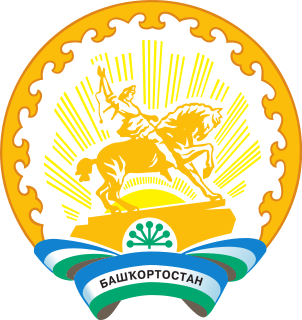 W
WThe coat of arms of Bashkortostan is a national symbol of the Republic of Bashkortostan, Russia.
 W
WCoat of arms of the London Borough of Bexley is the official coat of arms of the London Borough of Bexley, granted on 20 May 1965.
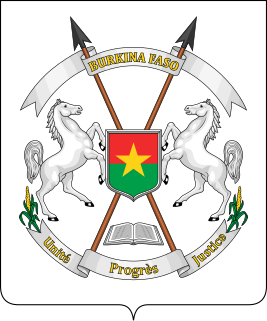 W
WThe coat of arms of Burkina Faso contains a shield based on the national flag. Above the shield the name of the country is shown, while below it is the national motto, Unité, Progrès, Justice. The supporters are two white stallions. The two plants emerging from the lower banner appear to represent pearl millet, an important cereal grain cultivated in this country where agriculture represents 32% of the gross domestic product. This coat of arms is similar to the old Upper Volta coat of arms, with the Burkina Faso flag replacing the Upper Volta flag in the middle. The coat of arms and its meaning is mandated by Law No 020/97/II/AN.
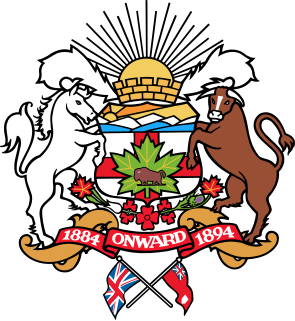 W
WThe coat of arms of Calgary, Alberta, was adopted in 1902. The arms existed only in black and white until 1984, when an alderman asked the City to develop it in full colour.
 W
WThe coat of arms of the London Borough of Bromley is the official coat of arms of the London Borough of Bromley, granted on 20 April 1965.
 W
WThe coat of arms of the London Borough of Croydon is the official heraldic arms of the London Borough of Croydon, granted on 10 December 1965.
 W
WThe coat of arms of Deva has been since 1999 the coat of arms used by the City Government of Deva, Romania. The arms of Deva, comprising the shield and the coronet, was modelled on the arms in use during the interwar period.
 W
WThe coat of arms of Georgia is one of the national symbols of the republic. It is partially based on the medieval arms of the Georgian royal house and features Saint George, the traditional patron saint of Georgia. In addition to St. George, the original proposal included additional heraldic elements found on the royal seal, such as the seamless robe of Jesus, but this was deemed excessively religious and was not incorporated into the final version.
 W
WThe Royal coat of arms of Great Britain was the coat of arms representing royal authority in the sovereign state of the Kingdom of Great Britain, in existence from 1707 to 1801. The kingdom came into being on 1 May 1707, with the political union of the kingdom of Scotland and the kingdom of England, which included Wales. With the 1706 Treaty of Union, it was agreed to create a single kingdom, encompassing the whole of the island of Great Britain and its outlying islands, but not Ireland, which remained a separate realm under the newly created British crown.
 W
WThe seal of the Territory of Idaho was adopted in 1863 and redrawn several times before statehood in 1890. The state Great Seal was designed by Emma Edwards Green, the only woman to design a state seal.
 W
WThe State Emblem of India is the national emblem of India and is used by the national government, many state governments and government agencies. The emblem is an adaptation of the Lion Capital of Ashoka, a statue from 280 BCE. The statue is a dimensional emblem showing four lions. It became the emblem of the Dominion of India in December 1947, and later the emblem of the Republic of India.
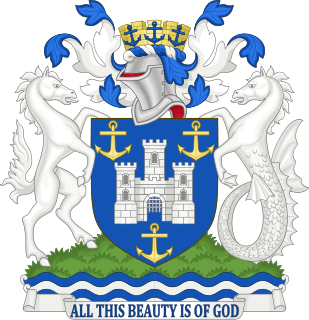 W
WThe coat of arms of the Isle of Wight was granted to the former Isle of Wight County Council in 1938. The arms were transferred to the new unitary Isle of Wight Council when the county council along with Medina and South Wight district councils were abolished in 1995.
 W
WThe Great Seal of the State of Kansas tells the history of Kansas.
 W
WThe coat of arms of Lesotho was adopted on 4 October 2006, after Lesotho's 40th anniversary of independence. Pictured is a crocodile on a Basotho shield. This is the symbol of the dynasty of Lesotho's largest ethnicity, the Bakoena. Behind the shield there are two crossed weapons, an assegai (lance) and a knobkierie (club). To the left and right of the shield are supporters of the shield, two Basutho horses. In the foreground there is a ribbon with the national motto of Lesotho: Khotso, Pula, Nala. The crocodile on the shield has been retained from the arms of Basutoland, the predecessor to Lesotho.
 W
WThe coat of arms of Lithuania, consisting of an armour-clad knight on horseback holding a sword and shield, is also known as Vytis. It is recognized as the official coat of arms of Lithuania since the early 15th century and is also known in other Lithuanian language names as Waikymas, Pagaunė or as Pogonia, Pogoń, Pahonia in the Polish, Belarusian and Ruthenian languages. Vytis should be translated as Chase, Pursuer, Knight or Horseman, similar to the Slavic word Витязь. Historically – raitas senovės karžygys or in heraldry – raitas valdovas. The coat of arms of Lithuania is one of the oldest national coats of arms in Europe.
 W
WThe coat of arms of the German federal-state of Lower Saxony shows a white Saxon steed on a red background.
 W
WThe coat of arms of Manitoba is the heraldic symbol representing the Canadian province of Manitoba. The arms contains symbols reflecting Manitoba's British heritage along with local symbols. At the upper part of the shield is the red cross of St. George, representing England. The lower portion of the shield features a bison standing atop a rock on a green background.
 W
WThe Great Seal of the State of Maryland is the official government emblem of the U.S. state of Maryland. Its official service is to authenticate acts by the General Assembly of Maryland, but it is also used for display purposes at most state buildings. Although the state seal has been changed in design several times throughout history, the current model represents the reverse side of the original seal.
 W
WThe Great Seal of the State of Minnesota is the state seal of the U.S. state of Minnesota. Originally adopted in 1858, it has undergone several alterations since then, in 1971 and 1983.
 W
WThe State Emblem of Mongolia is used by the government of Mongolia as its symbol of state. It is officially used for example on documents such as Mongolian passports, and government and embassy placards.
 W
WThe coat of arms of Moscow depicts a horseman with a spear in his hand slaying a basilisk and is identified with Saint George and the Dragon. The heraldic emblem of Moscow has been an integral part of the coat of arms of Russia since the 16th century.
 W
WThe coat of arms of the State of New Jersey includes:A shield with three plows, representative of New Jersey's agricultural tradition. A forward-facing helmet. A horse's head as the crest of the helmet. The female figures Liberty and Ceres, representative of the state's motto. Liberty is holding a staff supporting a stylized Phrygian cap; Ceres is holding an overflowing cornucopia. The streamer at the foot of the emblem contains the State Motto of New Jersey, "Liberty and Prosperity", and the year of statehood, 1776.
 W
WThe coat of arms of Nigeria consists of a black shield with a wavy white pall, symbolizing the meeting of the Niger and Benue Rivers at Lokoja. The black shield represents Nigeria's fertile soil, while the two supporting horses or chargers on each side represent dignity. The eagle represents strength, while the green and white bands on the top of the shield represent the rich soil.
 W
WThe coat of arms of North Rhine-Westphalia is the official coat of arms of the German state of North Rhine-Westphalia.
 W
WThe coat of arms of Oldenburg is the coat of arms associated with the state of Oldenburg, a county, duchy and then grand duchy that existed between 1101 and 1918. The arms are also associated with the parts of the House of Oldenburg that ruled the state.
 W
WThe coat of arms of Pennsylvania is an official emblem of the Commonwealth of Pennsylvania, alongside the seal and state flag, and was adopted in 1778. The flag of Pennsylvania consists of a blue field on which the state coat of arms is displayed.
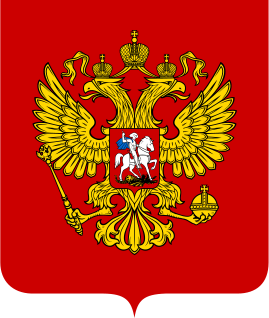 W
WThe coat of arms of Russia derives from the earlier coat of arms of the Russian Empire which was abolished with the Russian Revolution in 1917. Though modified more than once since the reign of Ivan III (1462–1505), the current coat of arms is directly derived from its medieval original, with the double-headed eagle having Byzantine and earlier antecedents. The general tincture corresponds to the early fifteenth-century standard.
 W
WThe Great Seal of the State of South Dakota was designed while the area was a territory, in 1885. The outer ring of the seal contains the text "State of South Dakota" on the top and "Great Seal" on the bottom. Also the year of statehood, 1889. Inside the inner circle of the seal contains the state motto "Under God the People Rule". The picture features hills, a river with a boat, a farmer, a mine, and cattle. The items in the image are to represent the state's commerce, agriculture, industry, and natural resources.
 W
WThe State Emblem of Turkmenistan was created after Turkmenistan gained independence from the Soviet Union in 1991. Like other post-Soviet republics whose symbols do not predate the October Revolution, the current emblem retains some components of the Soviet one such as cotton, wheat and rug. The eight-point green starburst with golden edges features in its center a red circular disc which carries sheaves of wheat, five carpet guls, and centered upon that a smaller blue circle with a lifelike depiction of former President Saparmurat Niyazov's pet Akhal-Teke horse Yanardag, a source of pride for the Turkmen people. A round variant of the emblem was used from 1992 until 2003, when President Saparmurat Niyazov proposed to change its appearance and said that the ancient Turkmen octagon has been considered to be a symbol of abundance, peace and tranquility.
 W
WThe emblem of Tuva is a light blue field with a yellow border. In the center of the field is a traditional horseman, symbolizing Tuva's sovereignty and spirit. The coat of arms was created in 1992, and is similar to the present state emblem of Mongolia, which was adopted that same year.
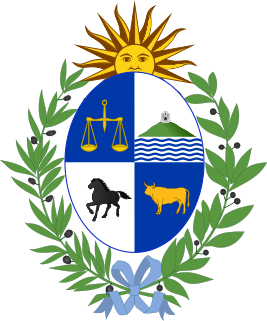 W
WThe coat of arms of Uruguay or Uruguayan shield was first adopted by law on March 19, 1829, and later on had some minor modification in 1906 and 1908. It was supposedly designed by Juan Manuel Besnes Irigoyen (1788–1865).
 W
WThe current coat of arms of Venezuela was primarily approved by the Congress on April 18, 1836, undergoing small modifications through history, reaching the present version.
 W
WThe Coat of arms of the Wakefield District was granted in 1990. Between 1974 and 1990, the council did not have arms that represented its governance of the expanded metropolitan district of the City of Wakefield, and used the arms of the County Borough of Wakefield. Arms had been granted to the district's constituent city and towns, but an application to the College of Arms was made for a unifying achievement.
 W
WThe coat of arms of Whitehorse is the full armorial achievement as used by the municipal government of Whitehorse as an official symbol. The arms were granted on 15 November 2002.
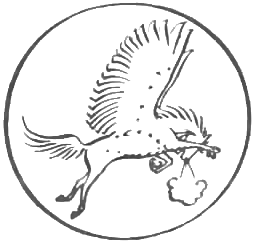 W
W